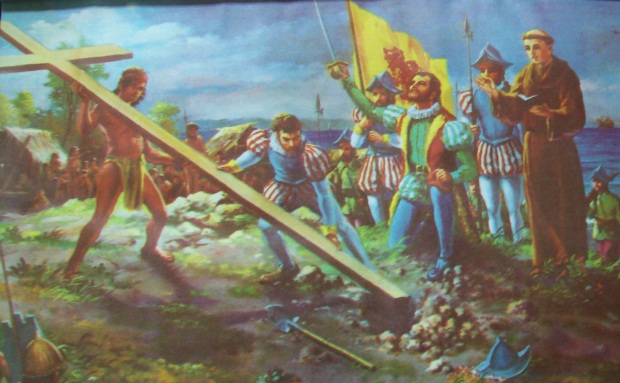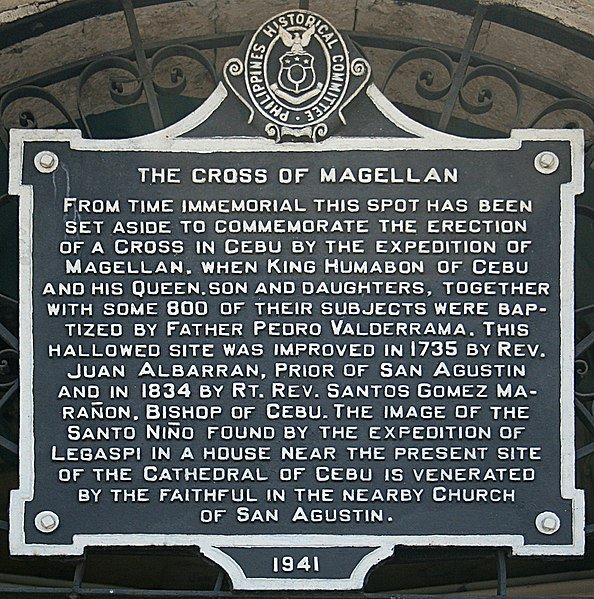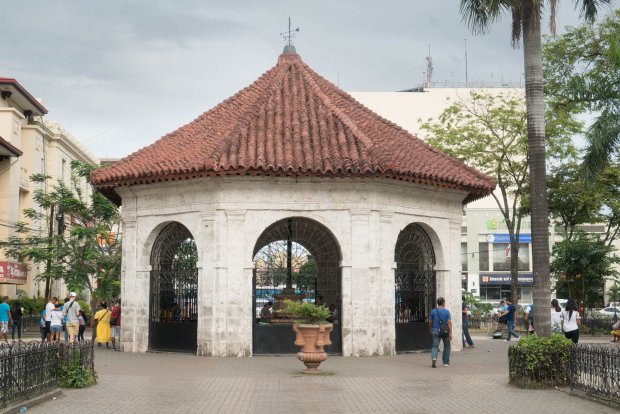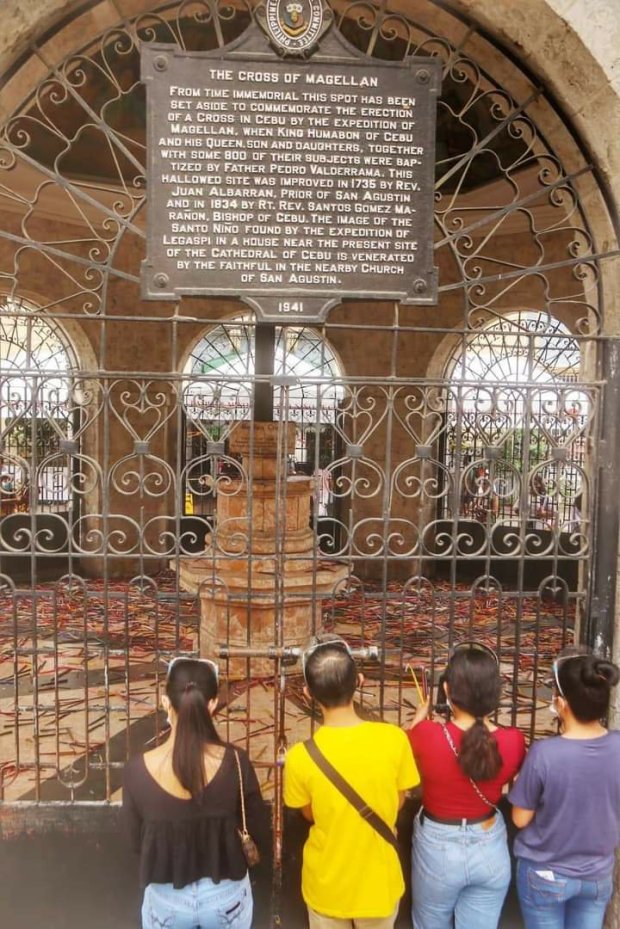
In the historic Cebu City, apart from the famed Minor Basilica of Santo Niño de Cebu – The Mother and Head of all Churches in the Philippines and home of the famous Santo Niño de Cebu, another famous landmark can that is inescapable to all who visit Cebu, a kiosk where it houses the Holy Cross that is believed to be the Cross that Ferdinand Magellan planted in Cebu. In recent years, new evidence suggests otherwise which shed light on the origin of this Cross. For this blog post, let us have a look at the mystery of this Holy Cross in Cebu City that commemorates the arrival of Christianity in the Philippines and the role of Cebu in the historic circumnavigation of the world.
The Cross

The famed Holy Cross of Magellan is a huge bare Cross of tidal wood with the INRI title on top where it encases an older cross which it was said that back then, pilgrims would chip the Cross due to its miraculous powers. The Cross stands and is housed in the middle of the Kiosk – Chapel where located in front of the present city hall of Cebu, along Magallanes Street near the Minor Basilica of Santo Nino de Cebu. A mural can be seen on the ceiling of the kiosk narrating the story of the arrival of the Catholic faith in Cebu. The Kiosk – Chapel is currently under the administration of the Augustinian Order.
The Landing in Cebu

On April 7, 1521, Ferdinand Magellan and his crew landed on Cebu island, a native chief, Rajah Humabon, met and befriended him. Rajah Humabon, his wife, and hundreds of his native warriors agreed to accept Christianity. Antonio Pigafetta recounts the planting of the Cross: “A large cross was set up in the middle of the square. The Captain General told them that if they wished to become Christians as they had declared on the previous days, they must burn all their idols and set up a cross in their place. They were to adore that cross daily with clasped hands, and every morning after their custom, they were to make the sign of the cross (which the Captain General showed them how to make); and they ought to come hourly, at least in the morning, to that cross, and adore it kneeling,”
Soon afterward, the First Baptism was held in Cebu on April 14, 1521, and gave the images of Santo Niño de Cebu, El Ecce Homo, and Nuestra Señora de los Remedios (Birhen sa Kotta). However, this good relationship ended with the Battle of Mactan on April 27, 1521, and left Cebu to continue the crew’s journey to the Moluccas and complete the first documented circumnavigation of the world.
On the authenticity of Magellan’s Cross

If we look at the narrative of Magallan’s arrival in the Philippines, there were other places where he planted a Cross in newly “discovered” lands in Homonhon, Samar, and Limasawa Island, Southern Leyte before doing the same act in Cebu. It is a custom for the Spaniards that they would plant a Cross on new lands they would conquer or “discover” as a sign of God’s presence and an act of possession. There were numerous accounts and studies made to point out some interesting points on the authenticity of the Cross. It is reported that the actual Cross that Magellan planted in Cebu was torn down when the Cebuanos turned against the Spaniards three weeks later after the Battle of Mactan. Numerous historians would later point out that a different cross was inside the bigger Tindalo cross casing enshrined at the kiosk.

Modern historians and scholars would note that the Cross that was inside the tindalo wood casing was a Cross that was believed to be that of Fray Martin de Rada, OSA when the Spaniards returned to Cebu in 1565. It is noted that during their return, a new Cross was planted and it was attributed to him that it was also called “Cruz de la Españoles” or “The Cross of de Rada”. Fray de Rada would later be known as the champion and protector of the natives of Cebu where he protected them from the abuse of the Spanish officials which earned him the name “Apostle of Cebu”.
It is also interesting to note that there was a certain episode in Cebu that would give this Cross a reputation of being a miraculous Holy Cross. It was during the Reconquista of the Spaniards and they are building the church and the convent that a fire broke out. When it was about to reach the Holy Cross, the fire went out suddenly which led the faithful to deem the Cross miraculous hence they chipped off some parts of the Cross to keep as relics or amulets.

Interestingly in 1967, a certain group of tour organizers placed the marker at the base of the Cross stating that it was that of Magellan’s by now, after many studies on the authenticity of the Cross, the claim is now being questioned, notably by Prof. Jobert Bersales of Cebu among others. Also, it is interesting to note that the claim of that particular marker was already contradicted by the older marker that dates back to 1941 which clearly states that is a memorial monument, not the exact spot where the Cross was planted.
The Kiosk

The kiosk was built on the site near the Santo Niño Basilica and convent in 1735 by Rev. Fr. Juan Albarran, OSA, Prior of San Agustin as a memorial monument of the arrival of Ferdinand Magellan in the country. In 1834, Rt. Rev. Santos Gomez Marañon, Bishop of Cebu (1830-1840) granted a plenary indulgence to the faithful who would venerate the Holy Cross on the Feast of the Triumph of the Cross.
When Cebu City was established in 1937, the Magellan Cross Kiosk is prominently shown in the official emblem of the city to emphasize its crucial role both in the province of Cebu and the entire nation in history.
In 1965, for the celebration of 400 Years of the Formal Evangelization of the Philippines, the Knights of Columbus Cebu Chapter took the initiative of restoring the chapel-kiosk in line with the celebrations and it became one of the key venues for the Quadricentennial Celebrations for processions, parades as well as the Memorial Mass for the 400 Years of Christian witnessing in the Philippines. A few decades later, on April 19, 2021, in celebration of the 500 Years of Christianity in the country, the Kiosk once again became one of the key venues for the celebration with a Memorial Mass offered near the Kiosk. That same day, the vicinity of the Chapel-Kiosk and the Basilica Minore of Sto. Niño de Cebu was declared National Cultural Treasure.
Traditions

The Holy Cross of Magellan was also getting a cult following over the past centuries where the faithful of Cebu deemed the Cross miraculous due to the favors granted thru prayer on this particular cross. it is from here that the pious act of offering candles to the Cross developed where the faithful can offer it directly on the base of the Cross or it can be lit at designated candle stations surrounding the Basilica and Kiosk area. Outside the Kiosk, on can witness candle vendors dancing the traditional Sinulog while holding the candles they were selling as an act of offering and supplication to Our Lord.
The Significance of the Magellan’s Cross
Despite the questions of authenticity of the Holy Cross of Magellan, it serves as a symbol of two of the most important events in history: the arrival of the Catholic faith in Southeast Asia and the role of our country in the first circumnavigation of the world. It is in this Cross that we boldly proclaimed our rich history and the strong faith that we Filipinos have despite the challenges that the nation faced over the past 500 years and conquered them all by the grace of God and His Mother.
References:
Bersales, Jobers, The Myth of Magellan’s Cross, Retrieved from https://www.flickr.com/groups/ssndc/discuss/72157617856142120/ on May 1, 2021.
Limpag, Max, “Is the original really encased inside Magellan’s Cross?”, Retrieved from https://mycebu.ph/article/magellan-cross-cebu/amp/ on April 12. 2021.
Ragaas, Sergio Fiques, Phil Robert, Alindajao, “Magellan’s Cross”, Lantwan Publications, Cebu, 2018.
“The Cross of Magellan”, Retrieved from https://santoninodecebubasilica.org/basilica-minore-del-santo-nino/magellans-cross/ on September 17, 2020.
